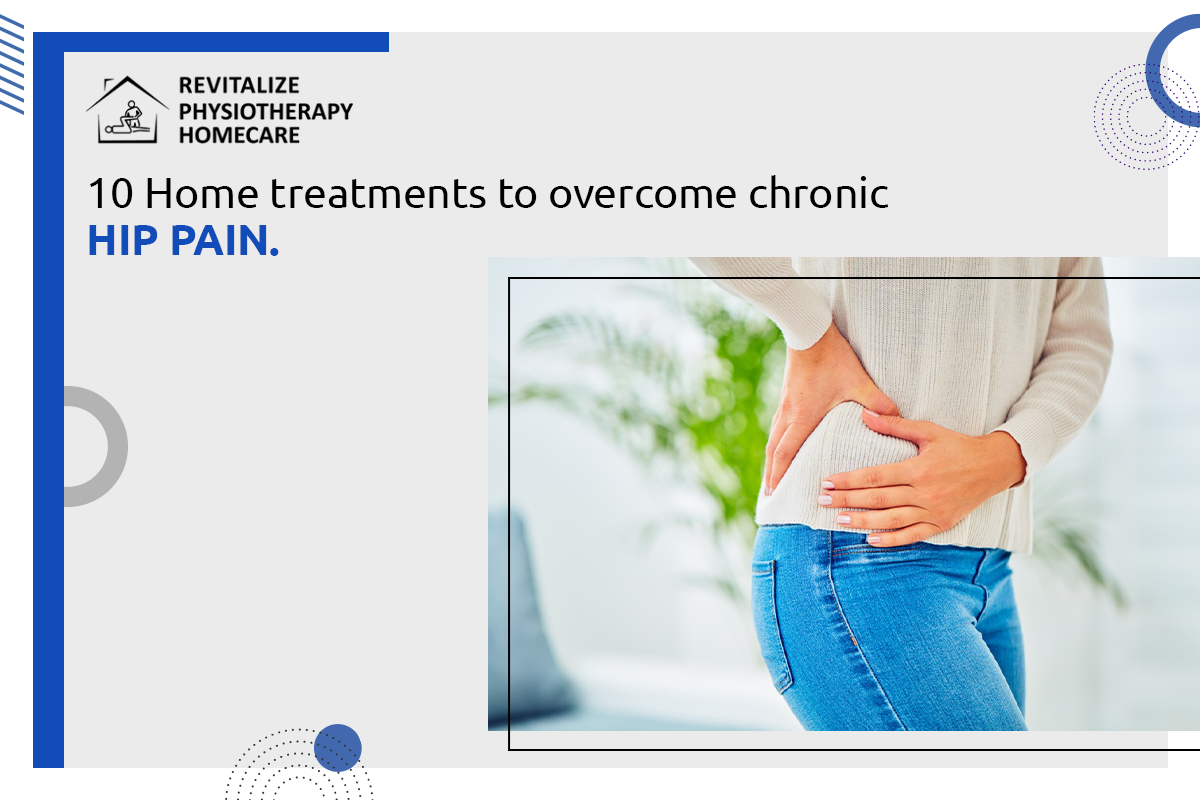10 Home treatments to overcome chronic Hip Pain at home
Many of you must have experienced hip discomfort at one time or another in your life. You can find out the source of your pain by knowing where it is coming from. Your hip joint muscles and other soft tissues may be causing pain in your hips, upper thighs, or outer buttocks.
A few common causes of hip pain consists:
Arthritis, Bursitis, Hip dislocation or hip fracture, Hip labral tear, Inguinal hernia, Hip sprains or strains, Muscle tendinitis, Pinched nerves, Osteoporosis, Osteomyelitis (bone infection), and Synovitis.
Hip pain can be debilitating and frustrating for some people, regardless of its cause. It doesn't matter if it's a minor inconvenience or a problem that hinders your daily activities; it is crucial to get treatment immediately. If left untreated, hip pain can cause physical compensation and further back or leg pain. And if needed you must also consider visiting a Hip Replacement Clinic Brampton. Apart from consulting a professional, there are many other ways to reduce pain and live normally.
Hip pain is difficult to diagnose because it includes your hips, intestines, and spine. This is why it becomes difficult to identify the cause.
As you age, hip pain becomes more common. This strong joint is subject to a lot of wear and tear throughout your life. However, the reason why women experience hip pain more than men is still unknown.
In this blog, we will discuss why it is important to manage your hip pain and home treatment to overcome it!
Why is it important that hip pain be managed?
Acute hip pain, if left untreated, can make it difficult to do many of your daily activities. Chronic pain can cause severe discomfort and hinder your quality of life. If chronic pain is allowed to persist, it can cause agitation, insomnia, and depression.
A professional Brampton Physiotherapist can help you recover and slow down the pain. During treatment, hip pain can vary in intensity and nature. In some cases, it may become more severe or frequent than before. If you are still experiencing pain, it is important to inform your doctor or physiotherapist. Even if the treatment has been completed, you must consult them.
You can avoid the discomfort that seems insignificant from becoming disruptive by learning how to treat hip pain at home.
Home treatment for hip pain
Hip pain can be short-term discomfort or a sign that you have a more serious problem. You might consider an at-home treatment if you experience mild or moderate hip pain.
A few of the home treatments are:
1. Exercise
Regular exercise is important for many reasons.
One reason is that it can help decrease hip pain. Exercise can be beneficial even if you're not in pain. It will strengthen your muscles, increase your range and help you avoid injury. You should modify your exercise routine to be less painful for your hips if you have already developed pain. Walking on a treadmill or flat track, and yoga that doesn't overextend the hip joint are some examples of ways to exercise. Walking or performing aerobic exercises in shallow water is another great way to exercise, such as at a recreation center or swimming.
2. Over-the-Counter Pain Medicine
Anti-inflammatory medication can be helpful if you are suffering from mild to moderate hip pain. These medications reduce inflammation which can help to decrease pain in the joints and muscles. These drugs are often inexpensive and easily available. Long-term use of NSAIDs can cause stomach and liver problems. Consult your doctor if you are planning to take them for more than a few days.
3. Take some time to relax
Although it may seem obvious, many patients need to remind themselves to rest. Hip pain can be a serious condition that is easier to manage if you don't re-aggravate it. You don't have to stop all activity or stay in bed. However, you should limit activities that involve the hip and prevent it from getting worse. Running, for example, is not recommended. However, you should ensure that you move enough to keep your hips from feeling stiff and sore from inactivity.
4. Apply Ice
A majority of doctors recommend that you apply ice to the injured hip every 15 minutes throughout the day. Ice can help reduce inflammation and dull nerve endings. Eventually making it less painful. You don't need an ice pack to achieve the same result. However, any cold object can be used. Patients often use frozen vegetables and similar items. However, you need to be careful not to defrost any food you intend to eat later. To avoid skin irritations and frostbite, ice should only be applied when wrapped in a towel or cloth.
5. Make use of compression
In most cases of overuse injuries, compression is a crucial step. After you have iced the injury properly, wrap your hips and pelvic region in a compression bandage. An ace bandage or any other type of sports wrap, can be used. By increasing blood circulation, compression can speed up the recovery of injured muscles. The bandage may also serve to remind you of your injury. Although compression is most commonly used to treat acute pain due to injury. Your doctor will be able to tell you if there are any hip pains related to arthritis.
6. Lift the Injury
Although it is difficult to raise your hip at home, a recliner can make it easier. This allows blood to flow to your hips and heart more easily and reduces swelling. You can relieve the pressure from your hip by lying on your opposite side if you are unable or unwilling to raise the injury. This will prevent you from aggravating the injury by sleeping on the opposite side. Be aware of your posture and avoid any positions that could stress the joint. As high as possible, raise your leg whenever you can.
7. Heat therapy
Heat can be used to relieve arthritis-related hip pain. Hot baths and showers can be therapeutic. Installing a shower chair or bench is a good option if your hip pain makes it difficult to sit or stand in the tub. Heating pads and other similar treatments can be used to treat joint pain due to arthritis or injury. However, heat can cause some conditions to become worse. Before you try this remedy, consult your doctor.
8. Do Stretches
Hip pain can be treated with many different stretches. You can have your pain assessed by a physiotherapist to help you choose the right stretch for you. Most commonly, gentle movements are used to stretch your hip muscles. They don't cause any pain and do not aggravate the joint. These movements typically involve kneeling or crouching. Your doctor may recommend something more gentle for your legs and knees if you are unable to do these stretches. For those suffering from bursitis, or who are recovering after an injury, stretching is best.
9. Lose Weight
Being overweight is one of the leading causes of hip pain. Losing weight can be done with a diet and exercise program. Avoid processed sugars, carbs, and eat healthy foods like vegetables and lean protein. You can still exercise, even if your pain makes it impossible to do so. You can lose weight and lower your pain by drinking more water and consuming less sugary beverages.
10. Surgery
The majority of hip pain patients will not need surgery. However, this option is available for those who have exhausted all other options and still cannot find relief. Most cases of hip pain will last for years before replacement or repair is required. This happens more often in cases of arthritis and degeneration. Surgery can also be performed to remove bone spurs. These are painful and often difficult to treat. While your doctor will help you decide if surgery is necessary, it can be very painful and requires long recovery times. You should also consider other options before you make this decision.
How Acupuncture Treatment can help lessen the hip pain
Acupuncture is a traditional Chinese medicine therapy that involves the insertion of thin needles into specific points on the body to stimulate healing and relieve pain. When it comes to hip pain, acupuncture can be an effective alternative to conventional treatment methods.
Here's how it can help:
- Stimulates circulation: Acupuncture improves blood flow to the hip area, reducing inflammation and promoting healing.
- Alleviates muscle tension: The needle stimulation can help to relieve muscle tension and stiffness around the hip, reducing pain.
- Releases endorphins: Acupuncture stimulates the release of endorphins, the body's natural pain-relieving chemicals, providing relief from hip pain.
- Improves joint function: Acupuncture can help improve joint function, reduce stiffness and increase mobility in the hip area.
- Reduces stress: Acupuncture has a calming effect and can help reduce stress, which can contribute to hip pain.
You can surely consider Acupuncture Treatments Brampton as it acts as an important role for effective treatment. Some people may need several sessions before they see significant improvement. It's always best to consult with a licensed acupuncturist to determine if this therapy is right for you.
Wrapping up
We hope this blog helps you comprehend more about hip pain and its treatments.
You can manage your hip pain by identifying the root cause and treating it correctly. Your hips may soon return to normal after minor injuries or accidents from exercise.
At Revitalize Physiotherapy and Homecare, we also treat more serious conditions like arthritis, fractures, or necrosis, your symptoms will likely worsen until you get treatment.
Book an appointment with our professionals for a customized treatment plan.




